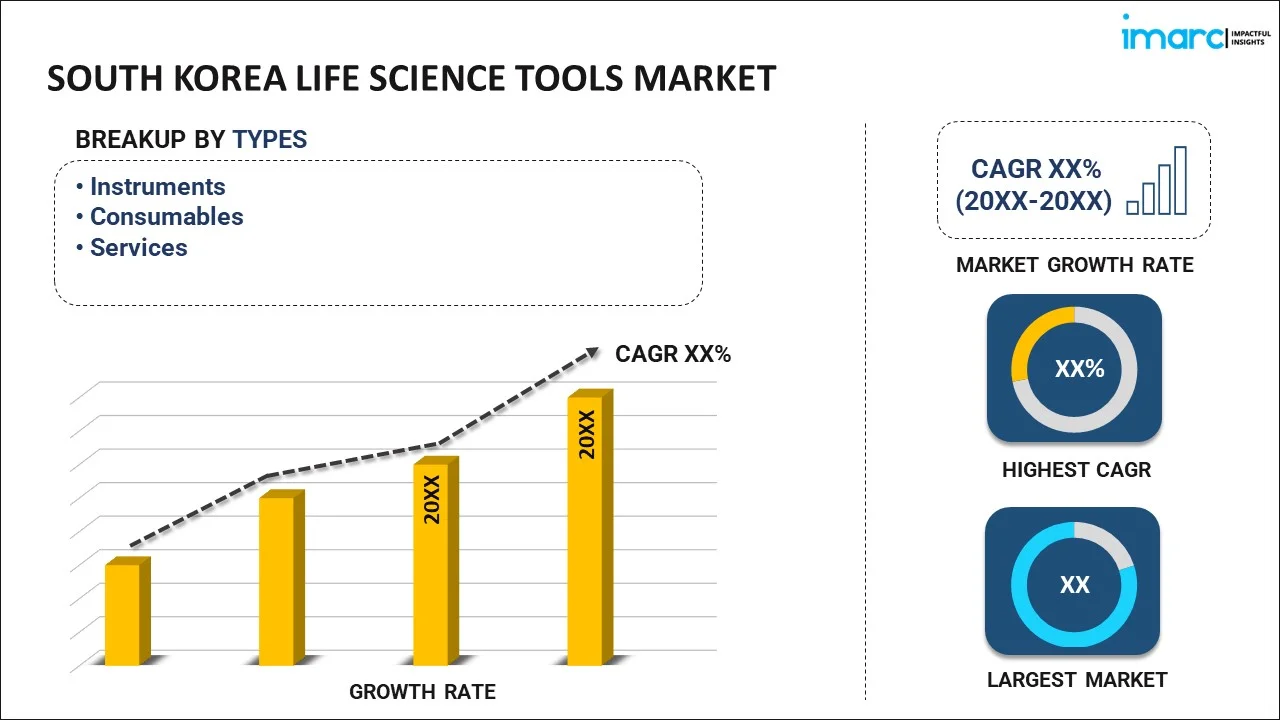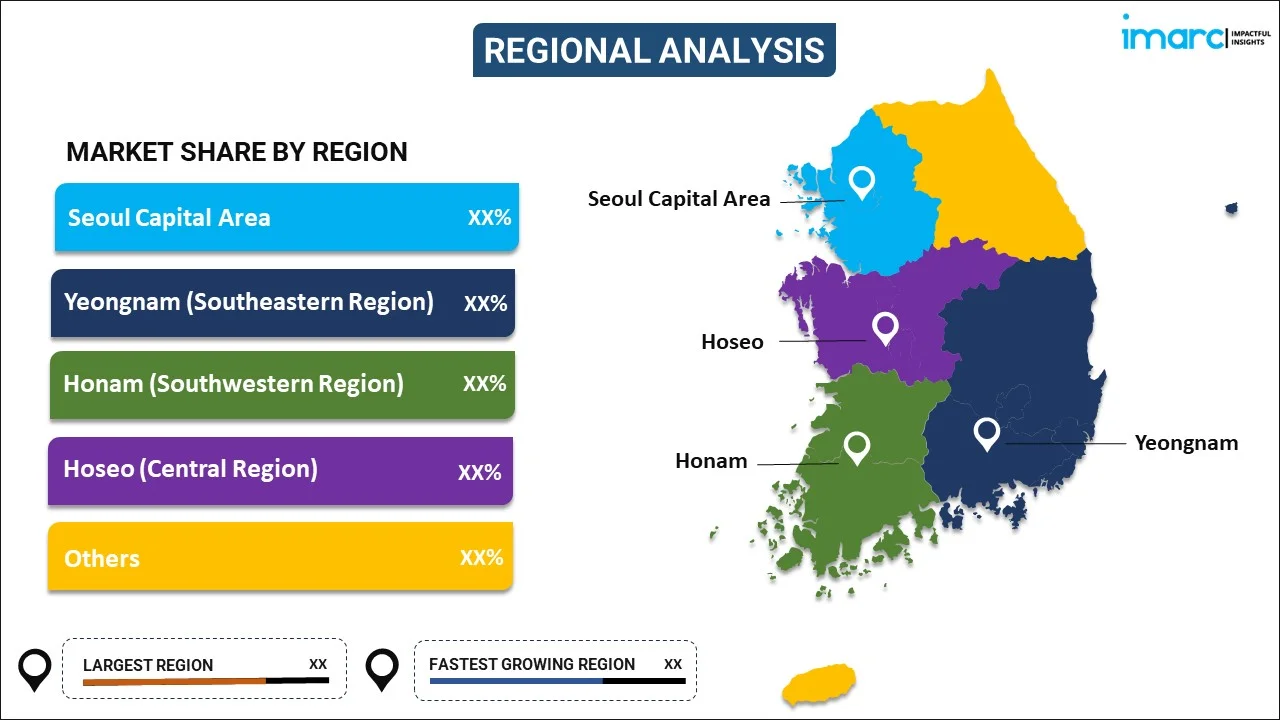
South Korea Life Science Tools Market Report by Type (Instruments, Consumables, Services), Technology (Cell Culture Systems and 3D Cell Culture, PCR and qPCR, Sanger Sequencing, Separation Technologies, Flow Cytometry, Nucleic Acid Microarray, Mass Spectrometry, and Others), Application (Proteomics Technology, Genomic Technology, Cell Biology Technology, and Others), End User (Government and Academic, Biopharmaceutical Company, Healthcare, Industrial Applications, and Others), and Region 2025-2033
Market Overview:
South Korea life science tools market size reached USD 3.1 Billion in 2024. Looking forward, IMARC Group expects the market to reach USD 5.7 Billion by 2033, exhibiting a growth rate (CAGR) of 6.1% during 2025-2033. Favorable government investments in research and development (R&D), a thriving biopharmaceutical industry, rising emphasis on genomic research, infectious disease response, growing demand for regenerative medicine, and the escalating awareness about environmental sustainability represent some of the key factors driving the market.
|
Report Attribute
|
Key Statistics
|
|---|---|
|
Base Year
|
2024
|
|
Forecast Years
|
2025-2033
|
|
Historical Years
|
2019-2024
|
|
Market Size in 2024
|
USD 3.1 Billion |
|
Market Forecast in 2033
|
USD 5.7 Billion |
| Market Growth Rate 2025-2033 | 6.1% |
Life science tools encompass a diverse array of instruments, equipment, and technologies designed for research, analysis, and experimentation within the field of life sciences. These tools play a crucial role in advancing our understanding of biological systems, from the molecular level to complex organisms. Some of the standard life science tools include microscopes for observing cellular structures, deoxyribonucleic acid (DNA) sequencers for unraveling genetic codes, mass spectrometers for analyzing biomolecules, and chromatography systems for separating complex mixtures. Besides this, advanced imaging technologies, such as fluorescence microscopy and flow cytometry, enable researchers to visualize and study living cells in unprecedented detail. Life science tools are utilized across various disciplines, including genetics, biochemistry, pharmacology, and microbiology, facilitating groundbreaking discoveries and innovations. The continuous development of cutting-edge life science tools empowers scientists to delve deeper into the intricacies of life, unraveling mysteries at the cellular and molecular levels and contributing to advancements in medicine, agriculture, and environmental science.
South Korea Life Science Tools Market Trends:
South Korea's commitment to scientific research, technological advancements, and healthcare innovation represents the key factor driving its life science tools market. In line with this, the government's substantial investments in R&D, coupled with policies fostering a conducive environment for scientific exploration, have catalyzed the demand for cutting-edge life science tools, strengthening the market growth. Moreover, the rising emphasis on health and biotechnology leading to increased funding for research projects is creating a favorable market outlook for life science tool providers. Besides this, South Korea's thriving biopharmaceutical industry, marked by the presence of major players and a focus on developing innovative therapies, has elevated the demand for sophisticated tools for drug discovery, development, and production, contributing to the market expansion. Concurrently, the pursuit of precision medicine and personalized therapies spurring the need for advanced life science tools that enable precise molecular analyses is acting as another significant growth-inducing factor. In addition to this, the growing prevalence of chronic diseases and the aging population have intensified efforts in medical research, thus bolstering the demand for life science tools in diagnostics and disease understanding. Furthermore, South Korea's ambitious initiatives in genomics and genetic research contribute to the demand for high-throughput sequencing and gene editing tools, providing an impetus to the market growth. Apart from this, the global focus on combating infectious diseases, highlighted by events such as the COVID-19 pandemic, has heightened the demand for diagnostic tools, molecular biology equipment, and other life science tools essential for rapid response and research, thereby propelling the market forward.
South Korea Life Science Tools Market Segmentation:
IMARC Group provides an analysis of the key trends in each segment of the market, along with forecasts at the country level for 2025-2033. Our report has categorized the market based on type, technology, application, and end user.
Type Insights:

- Instruments
- Consumables
- Services
The report has provided a detailed breakup and analysis of the market based on the type. This includes instruments, consumables, and services.
Technology Insights:
- Cell Culture Systems and 3D Cell Culture
- PCR and qPCR
- Sanger Sequencing
- Separation Technologies
- Flow Cytometry
- Nucleic Acid Microarray
- Mass Spectrometry
- Others
A detailed breakup and analysis of the market based on the technology have also been provided in the report. This includes cell culture systems and 3D cell culture, PCR and qPCR, sanger sequencing, separation technologies, flow cytometry, nucleic acid microarray, mass spectrometry, and others.
Application Insights:
- Proteomics Technology
- Genomic Technology
- Cell Biology Technology
- Others
The report has provided a detailed breakup and analysis of the market based on the application. This includes proteomics technology, genomic technology, cell biology technology, and others.
End User Insights:
- Government and Academic
- Biopharmaceutical Company
- Healthcare
- Industrial Applications
- Others
A detailed breakup and analysis of the market based on the end user have also been provided in the report. This includes government and academic, biopharmaceutical company, healthcare, industrial applications, and others.
Regional Insights:

- Seoul Capital Area
- Yeongam (Southeastern Region)
- Honam (Southwestern Region)
- Hoseo (Central Region)
- Others
The report has also provided a comprehensive analysis of all the major regional markets, which include Seoul Capital Area, Yeongam (Southeastern Region), Honam (Southwestern Region), Hoseo (Central Region), and Others.
Competitive Landscape:
The market research report has also provided a comprehensive analysis of the competitive landscape in the market. Competitive analysis such as market structure, key player positioning, top winning strategies, competitive dashboard, and company evaluation quadrant has been covered in the report. Also, detailed profiles of all major companies have been provided.
South Korea Life Science Tools Market Report Coverage:
| Report Features | Details |
|---|---|
| Base Year of the Analysis | 2024 |
| Historical Period | 2019-2024 |
| Forecast Period | 2025-2033 |
| Units | Billion USD |
| Scope of the Report | Exploration of Historical and Forecast Trends, Industry Catalysts and Challenges, Segment-Wise Historical and Predictive Market Assessment:
|
| Types Covered | Instruments, Consumables, Services |
| Technologies Covered | Cell Culture Systems and 3D Cell Culture, PCR and qPCR, Sanger Sequencing, Separation Technologies, Flow Cytometry, Nucleic Acid Microarray, Mass Spectrometry, Others |
| Applications Covered | Proteomics Technology, Genomic Technology, Cell Biology Technology, Others |
| End Users Covered | Government and Academic, Biopharmaceutical Company, Healthcare, Industrial Applications, Others |
| Regions Covered | Seoul Capital Area, Yeongnam (Southeastern Region), Honam (Southwestern Region), Hoseo (Central Region), Others |
| Customization Scope | 10% Free Customization |
| Post-Sale Analyst Support | 10-12 Weeks |
| Delivery Format | PDF and Excel through Email (We can also provide the editable version of the report in PPT/Word format on special request) |
Key Questions Answered in This Report:
- How has the South Korea life science tools market performed so far and how will it perform in the coming years?
- What has been the impact of COVID-19 on the South Korea life science tools market?
- What is the breakup of the South Korea life science tools market on the basis of type?
- What is the breakup of the South Korea life science tools market on the basis of technology?
- What is the breakup of the South Korea life science tools market on the basis of application?
- What is the breakup of the South Korea life science tools market on the basis of end user?
- What are the various stages in the value chain of the South Korea life science tools market?
- What are the key driving factors and challenges in the South Korea life science tools?
- What is the structure of the South Korea life science tools market and who are the key players?
- What is the degree of competition in the South Korea life science tools market?
Key Benefits for Stakeholders:
- IMARC’s industry report offers a comprehensive quantitative analysis of various market segments, historical and current market trends, market forecasts, and dynamics of the South Korea life science tools market from 2019-2033.
- The research report provides the latest information on the market drivers, challenges, and opportunities in the South Korea life science tools market.
- Porter's five forces analysis assist stakeholders in assessing the impact of new entrants, competitive rivalry, supplier power, buyer power, and the threat of substitution. It helps stakeholders to analyze the level of competition within the South Korea life science tools industry and its attractiveness.
- A competitive landscape allows stakeholders to understand their competitive environment and provides an insight into the current positions of key players in the market.
Need more help?
- Speak to our experienced analysts for insights on the current market scenarios.
- Include additional segments and countries to customize the report as per your requirement.
- Gain an unparalleled competitive advantage in your domain by understanding how to utilize the report and positively impacting your operations and revenue.
- For further assistance, please connect with our analysts.
 Inquire Before Buying
Inquire Before Buying
 Speak to an Analyst
Speak to an Analyst
 Request Brochure
Request Brochure
 Request Customization
Request Customization




.webp)




.webp)












